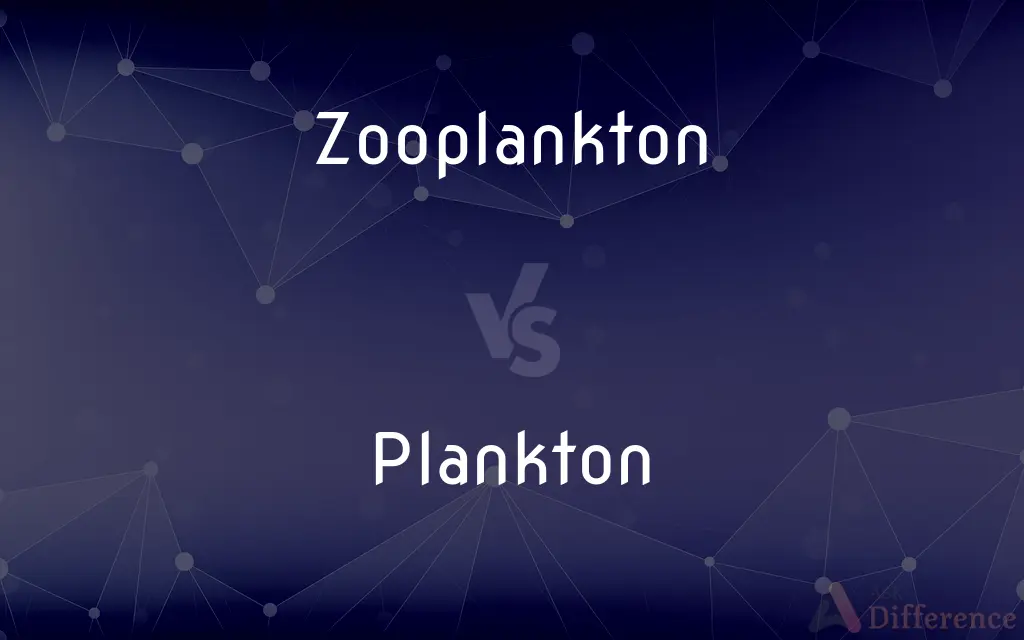Zooplankton vs. Plankton — What's the Difference?
By Tayyaba Rehman & Urooj Arif — Updated on April 26, 2024
Zooplankton are heterotrophic plankton, feeding on other microscopic organisms, whereas plankton includes both phytoplankton (photosynthetic) and zooplankton.

Difference Between Zooplankton and Plankton
Table of Contents
ADVERTISEMENT
Key Differences
Zooplankton are small, often microscopic organisms that drift in water bodies and primarily depend on other organisms for food, while plankton encompasses a broader category, including both organisms that produce their food via photosynthesis (phytoplankton) and those that do not (zooplankton).
Zooplankton include various animals and protozoans that feed on microscopic plants or other zooplankton, whereas plankton can also include phytoplankton like algae, which produce their own food through photosynthesis.
The ecological role of zooplankton primarily involves being consumers in the aquatic food web, whereas plankton, in general, includes both producers (like phytoplankton) and consumers (zooplankton), playing multiple roles in the ecosystem.
Zooplankton are typically found at different depths in the water, often undergoing daily vertical migrations, while plankton as a whole can vary more widely in distribution, from surface waters to deeper layers, depending on the type.
In terms of size, zooplankton can range from microscopic to several inches long (like jellyfish larvae), whereas plankton varies from microscopic phytoplankton to larger forms such as krill and even some jellyfish, showcasing a broader size range.
ADVERTISEMENT
Comparison Chart
Definition
Heterotrophic organisms in the water column
All organisms drifting in the water column
Types
Animal and protozoan consumers
Includes both producers and consumers
Nutritional Method
Feeds on other organisms
Photosynthesis and consumption
Role in Ecosystem
Consumers
Both producers and consumers
Size Range
Microscopic to several inches
Microscopic to several feet
Compare with Definitions
Zooplankton
Small aquatic drifters that feed on other microscopic organisms.
Zooplankton populations fluctuate greatly with seasonal changes in water conditions.
Plankton
Drifting organisms in oceans, seas, and bodies of fresh water.
Plankton thrive in nutrient-rich waters, supporting diverse marine life.
Zooplankton
Indicator species for changes in the aquatic environment.
Scientists monitor zooplankton to gauge water health.
Plankton
Base of the aquatic food web, including photosynthetic phytoplankton.
Phytoplankton contribute significantly to global oxygen production.
Zooplankton
Consumers in the aquatic food web, often serving as prey for larger species.
Fish and whale sharks filter zooplankton from the water as a primary food source.
Plankton
Comprises both microorganisms like algae and large organisms like jellyfish.
Jellyfish larvae are considered part of the plankton community.
Zooplankton
Includes species like copepods and krill.
Krill, a type of zooplankton, is crucial for Antarctic ecosystems.
Plankton
Affected by water temperature, light, and nutrient availability.
Plankton blooms are common when conditions favor rapid growth.
Zooplankton
Can perform vertical migrations in the water column.
Zooplankton migrate vertically daily to escape predators and seek food.
Plankton
Monitored for ecological and environmental health.
Changes in plankton populations can indicate shifts in marine conditions.
Zooplankton
Zooplankton (, ) are heterotrophic (sometimes detritivorous) plankton (cf. phytoplankton).
Plankton
Plankton are the diverse collection of organisms found in water (or air) that are unable to propel themselves against a current (or wind). The individual organisms constituting plankton are called plankters.
Zooplankton
Plankton that consists of animals, including copepods, rotifers, jellyfish, and the larvae of sessile animals such as coral and sea anemones.
Plankton
The small or microscopic organisms that drift or swim weakly in a body of water, including bacteria, diatoms, jellyfish, and various larvae. Plankton is an important food source for fish and other larger organisms.
Zooplankton
(zoology) Free-floating small protozoa, crustaceans (such as krill), etc. and the eggs and larvae from larger animals.
Plankton
(uncountable) Organisms, especially small and microscopic ones, that drift in water.
Zooplankton
Animal constituent of plankton; mainly small crustaceans and fish larvae
Plankton
(uncountable) A plankter, any single organism that drifts in water.
Plankton
All the animals and plants, taken collectively, which live at or near the surface of salt or fresh waters.
Plankton
The aggregate of small plant and animal organisms that float or drift in great numbers in fresh or salt water
Common Curiosities
What role do zooplankton play in carbon sequestration?
Zooplankton contribute to carbon sequestration by consuming carbon-rich food and excreting it deep in the ocean.
How long do zooplankton live?
Lifespans vary widely; some zooplankton live only a few days, while others can live for several months.
Do all zooplankton live in saltwater?
No, zooplankton can be found in both saltwater and freshwater environments.
Do plankton move on their own?
Most plankton drift with currents, though many, like zooplankton, can also swim to navigate through water.
How do plankton affect the atmosphere?
Phytoplankton in plankton absorb carbon dioxide and release oxygen, significantly impacting global carbon cycles and oxygen levels.
What is the difference between zooplankton and nekton?
Zooplankton drift with water currents and have limited swimming ability, whereas nekton are strong swimmers and can move independently of water currents.
What environmental factors affect plankton populations?
Temperature, light, nutrients, and water currents all significantly influence plankton populations.
What is the largest type of plankton?
Jellyfish can be considered the largest type of plankton when in their larval stage.
What happens to plankton levels during an algae bloom?
During an algae bloom, phytoplankton levels sharply increase, which can disrupt local ecosystems and marine life.
How do zooplankton find food?
Zooplankton use various sensory mechanisms to detect food, such as chemical cues in the water.
How do scientists study plankton?
Scientists use nets to collect plankton samples and microscopes to study their characteristics and behaviors.
Can changes in plankton populations indicate environmental changes?
Yes, changes in plankton populations can be early indicators of environmental changes like shifts in climate or water quality.
Are zooplankton affected by pollution?
Yes, zooplankton are sensitive to changes in water quality and can be adversely affected by pollution.
Share Your Discovery

Previous Comparison
Sited vs. Cited
Next Comparison
Inquiry vs. QueryAuthor Spotlight
Written by
Tayyaba RehmanTayyaba Rehman is a distinguished writer, currently serving as a primary contributor to askdifference.com. As a researcher in semantics and etymology, Tayyaba's passion for the complexity of languages and their distinctions has found a perfect home on the platform. Tayyaba delves into the intricacies of language, distinguishing between commonly confused words and phrases, thereby providing clarity for readers worldwide.
Co-written by
Urooj ArifUrooj is a skilled content writer at Ask Difference, known for her exceptional ability to simplify complex topics into engaging and informative content. With a passion for research and a flair for clear, concise writing, she consistently delivers articles that resonate with our diverse audience.
















































